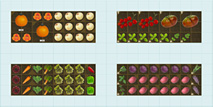How to grow Melon?
- Latin Family: Cucurbitaceae
- Latin Genus: Cucumis
- Ease of Growing: Moderate
- Growing Type: Annual
The melon has been called "The noblest production of the garden." It is a member of the Cucurbit family and is grown in much the same way as the related Cucumbers, though it isn't quite as vigorous when young. It is actually fairly easy to grow in a warm hospitable climate, less so in cooler areas.
Videos
Melon History
This succulent tropical fruit originated in Africa. It was introduced into Britain in the sixteenth century, where it was grown in hotbeds made with manure.
Soil Preference
- PH (min/max): 6.0 - 7.0
- PH Ideal (min/max): 6.3 - 6.6
The ideal soil for Melons is loose, moist, fertile, well-drained and fairly neutral.
Melons don't need a lot of nitrogen, as this encourages leaf growth at the expense of fruit. They do like phosphorus (give them colloidal phosphate) and potassium (wood ashes), as well as boron and magnesium.
How to care for Melon?
Melons aren't particularly hard to grow if they have everything they need (heat, water, fertile soil). They are susceptible to quite a few diseases though.
Water
Melons are quite shallow rooted, so need fairly constant water. The best way to water them is with a drip system or soaker hose, as they don't like having wet leaves (this encourages fungus disease).
Fertilizer
Melons are fairly hungry plants. They don't like a lot of nitrogen, but they do need plenty of phosphorus and potassium.
Seeds
Seed Viability: 2-4 years
Germination Percentage: 80.0
Melons are cross pollinated by insects so you can either grow only one variety at a time, isolate by a 1/2 mile, cage them or hand pollinate.
Hand pollinating Melons isn't difficult, though the flowers are smaller than other Cucurbits. The flowers are most receptive to pollination before any fruit start growing. Once there are fruit maturing on the plant they become less inclined to produce more by pollinating successfully.
You need to prepare to pollinate the flowers the night before, by finding some male and female flowers (the female has a tiny "melon" behind the flower) that are about to open the following day. Tape them shut with a little piece of masking tape (don't tape it too well or it will be hard to remove without damaging the flower). This prevents them from opening and being pollinated before you get to them.
The next day pick a male flower and remove its tape and petals. Then carefully open a female flower (from a different plant), being very careful to not damage the petals. Insert the male flower into a female flower and brush the pollen from the anthers on to stigma. Finally tape the female flower closed again. The petals will soon fall off and if pollination was successful the tiny fruit will begin to grow.
If you are adventurous, you could collect the seed from any ripe fruit as you eat it (so long as it isn't an F1 hybrid) and see what grows. In the case of Melons, I would avoid hybrids for this reason, it seems a shame not to be able to use some of those seeds.
Light
Sun: min. 6 hours daily
Melons need full sun.
Conditions:Warm, Hot
Season:Short Season, Long Season
Storage
Melons can be stored in a fridge for a couple of weeks, but their flavor will slowly deteriorate (they are best eaten immediately).
Storage Req: Refrigerator
Storage Temp: 35-40°F
Storage Length: 1-14 days
The fruit should be treated like Tomatoes and kept at room temperature. Ideally they should be eaten as soon as possible, as they will only deteriorate over time.
Storage Req:
Storage Temp: 55-65°F
Storage Length: 1-2 days
Problems
Pests
Melons are related to Cucumbers and suffer from many of the same afflictions. They are particularly vulnerable when small, so should be protected carefully at this time. You can use row covers if any serious pest problems occur.
Melon Types
- Mix
- Asian
- European Cantaloupe
- Muskmelon
- Honeydew & Casaba
A mix of summer melons.
Asian melons are oval shaped and have a deep golden color with white stripes. The flesh is white and thick, crisp and very sweet.
Round or oval cantaloupe found in Europe. Skin is beige with a gray toned netting with a well defined seam. Flesh is orange and meat is fragrant when ripe.
Muskmelon is a summer melon generally sold as the common cantaloupe. The outer skin is a netted texture with seams defining wedges.
Honeydew and Casaba melons both grow on a vine yet they have different types of skin. Honeydew has a smooth, brownish-green skin, while Casaba produces a slightly wrinkled, yellow skin. Honeydew typically has light green flesh while the Casabas is either white, yellow or orange.
Pests
- Birds
- Cucumber Beetle
- Rabbits
- Raccoons
- Aphids
- Deer
- Gophers
- Leafhoppers
- Squash Bug
- Squash Vine Borers
- Armyworms
Diseases
- Anthracnose
- Mosaic Virus (Several species)
- Bacterial Wilt
- Fusarium Wilt
- Damping Off
- Early Blight
- Alternaria Blight
- Powdery Mildew
